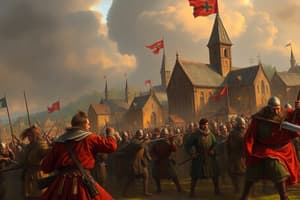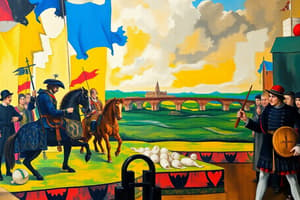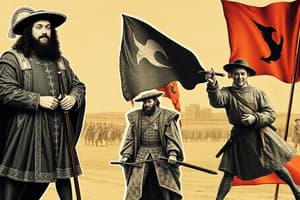Podcast
Questions and Answers
Which event marked the beginning of the Thirty Years' War?
Which event marked the beginning of the Thirty Years' War?
- The Edict of Nantes
- The Peace of Augsburg
- The Defenestration of Prague (correct)
- The Treaty of Westphalia
Louis XIV believed in the divine right of kings, which means he ruled without any limitations from the nobility.
Louis XIV believed in the divine right of kings, which means he ruled without any limitations from the nobility.
True (A)
What was the significance of the Peace of Westphalia?
What was the significance of the Peace of Westphalia?
It ended the Thirty Years' War and established a new order of religious tolerance in Europe.
The _____ was a crucial document that resulted from the Glorious Revolution and outlined Parliament's power.
The _____ was a crucial document that resulted from the Glorious Revolution and outlined Parliament's power.
Match the following English monarchs with their key actions or characteristics:
Match the following English monarchs with their key actions or characteristics:
What was one impact of the Thirty Years' War on Germany?
What was one impact of the Thirty Years' War on Germany?
The Dutch Golden Age was characterized by a focus on religious orthodoxy and strict monarchial rule.
The Dutch Golden Age was characterized by a focus on religious orthodoxy and strict monarchial rule.
What reform did Colbert implement in France during Louis XIV's reign?
What reform did Colbert implement in France during Louis XIV's reign?
What was the primary motivation for exploration during the Age of Exploration?
What was the primary motivation for exploration during the Age of Exploration?
The Great Schism referred to the division among European powers during the Thirty Years' War.
The Great Schism referred to the division among European powers during the Thirty Years' War.
Who is considered the father of Humanism?
Who is considered the father of Humanism?
The 95 Theses were a critique of the practice of _____ in the Catholic Church.
The 95 Theses were a critique of the practice of _____ in the Catholic Church.
Match the following artists with their contributions:
Match the following artists with their contributions:
What was the primary impact of the printing press invented by Gutenberg?
What was the primary impact of the printing press invented by Gutenberg?
Calvinism emphasizes the doctrine of predestination.
Calvinism emphasizes the doctrine of predestination.
What was the significance of the Edict of Nantes?
What was the significance of the Edict of Nantes?
The concept of _____ refers to the idea that wealth is fixed and can be gained only at the expense of others.
The concept of _____ refers to the idea that wealth is fixed and can be gained only at the expense of others.
Which event marked the beginning of the Protestant Reformation?
Which event marked the beginning of the Protestant Reformation?
Elizabeth I's religious settlement sought to compromise between Catholicism and Protestantism.
Elizabeth I's religious settlement sought to compromise between Catholicism and Protestantism.
What was the role of Jesuits during the Counter-Reformation?
What was the role of Jesuits during the Counter-Reformation?
The _____ was an agreement dividing newly discovered lands between Spain and Portugal.
The _____ was an agreement dividing newly discovered lands between Spain and Portugal.
Match the exploration terms with their meanings:
Match the exploration terms with their meanings:
Flashcards
Peace of Augsburg
Peace of Augsburg
The Peace of Augsburg (1555) recognized the right of each German ruler to determine the religion of their state, either Catholicism or Lutheranism. This attempted to resolve religious tensions in the Holy Roman Empire but ultimately failed to prevent the Thirty Years’ War.
Defenestration of Prague
Defenestration of Prague
The Defenestration of Prague (1618) was a pivotal event in the Thirty Years' War. Protestant nobles in Bohemia tossed two royal officials out of a window, sparking a conflict that erupted into a wider European war over religion and power.
Cardinal Richelieu
Cardinal Richelieu
Louis XIII's chief minister, Cardinal Richelieu, played a crucial role in strengthening the power of the French monarchy. He aimed to reduce the influence of nobles and strengthen the king's authority, even if it meant siding with Protestants against the Catholic Hapsburgs during the Thirty Years' War.
Peace of Westphalia
Peace of Westphalia
Signup and view all the flashcards
Louis XIV
Louis XIV
Signup and view all the flashcards
Versailles
Versailles
Signup and view all the flashcards
Dutch Golden Age
Dutch Golden Age
Signup and view all the flashcards
Glorious Revolution
Glorious Revolution
Signup and view all the flashcards
Black Death: Impact
Black Death: Impact
Signup and view all the flashcards
Black Death: Economic Impact
Black Death: Economic Impact
Signup and view all the flashcards
Hundred Years' War
Hundred Years' War
Signup and view all the flashcards
Babylonian Captivity
Babylonian Captivity
Signup and view all the flashcards
Great Schism
Great Schism
Signup and view all the flashcards
Petrarch and Humanism
Petrarch and Humanism
Signup and view all the flashcards
Renaissance Art: Differences
Renaissance Art: Differences
Signup and view all the flashcards
Renaissance Art: Characteristics
Renaissance Art: Characteristics
Signup and view all the flashcards
Leonardo da Vinci
Leonardo da Vinci
Signup and view all the flashcards
Michelangelo
Michelangelo
Signup and view all the flashcards
Raphael
Raphael
Signup and view all the flashcards
Renaissance Thought: Individualism
Renaissance Thought: Individualism
Signup and view all the flashcards
Northern Renaissance: Location
Northern Renaissance: Location
Signup and view all the flashcards
Gutenberg and the Printing Press
Gutenberg and the Printing Press
Signup and view all the flashcards
Christian Humanism
Christian Humanism
Signup and view all the flashcards
Erasmus and In Praise of Folly
Erasmus and In Praise of Folly
Signup and view all the flashcards
Study Notes
Thirty Years’ War
- Religious tension fueled by the Peace of Augsburg sparked the Thirty Years' War.
- The Defenestration of Prague acted as a catalyst.
- The war was a conflict involving major European powers, including struggles over both religion and political power.
- France, under Louis XIII and Cardinal Richelieu, sought to diminish Habsburg power, a key factor in their involvement.
- The Peace of Westphalia ended the war, shifting the balance of power.
- The war's impact on Germany was significant, including widespread devastation.
Louis XIV
- Louis XIV embodied absolutism, famously proclaiming "L'état c'est moi" (The state is me).
- Characteristics of an absolute monarch included centralized power and divine right.
- The Palace of Versailles served as a symbol of power, impacting the French nobility through lavish displays and social pressure.
- The economy suffered due to excessive spending and extravagant court life at Versailles.
- Louis XIV's administration involved restructuring the bureaucracy.
- The Edict of Fontainebleau revoked the Edict of Nantes, leading to religious persecution.
- Jean-Baptiste Colbert's policies focused on strengthening the French economy through mercantilist strategies and taxation.
- François Michel le Tellier, Marquis de Louvois, managed the French military and spearheaded warfare.
- Maintaining a European balance of power was a continual concern for Louis XIV.
- The French economy faced strain due to ongoing wars.
- The War of the Spanish Succession involved France and its Grand Alliance opponents.
- The Treaty of Utrecht concluded this conflict and significantly reshaped the political map, impacting French power.
Constitutionalism
- The Dutch Republic, also known as the Dutch Golden Age, presented an alternative to absolute monarchy, emphasizing republican ideals and commerce.
- Key aspects included wealth from trade, scientific advancements, as well as artistic achievements, including unique types of art flourishing in that time period.
- England's experience with constitutionalism involved a complex interplay of monarchical authority and parliamentary power.
- Magna Carta, Elizabeth I's reign, and the Stuart dynasty represent key stages in this process.
- Religious conflict and disputes over royal power shaped the reigns of James I, Charles I, and the English Civil War.
- The English Civil War, a conflict between Parliament and the Crown, ended the reign of Charles I.
- Cromwell's Protectorate and the Restoration under Charles II were significant steps in England's political development.
- James II's policies raised concerns about his legitimacy, ultimately leading to the Glorious Revolution.
- William and Mary accepted the English Bill of Rights, which established limitations on royal power and reinforced parliamentary sovereignty.
- The Hanover dynasty marked an evolution towards a limited constitutional monarchy, strengthening parliamentary influence.
Crisis of Late Middle Ages
- The Late Middle Ages were characterized by crises including a population decline caused by the Great Famine and the Black Death.
- These events led to significant economic hardship and social unrest, including widespread peasant revolts.
- The Hundred Years' War added to the instability of this time period.
Renaissance
- Petrarch, a key figure of the Renaissance, championed humanism.
- Renaissance art differed from earlier styles through its focus on humanism and realism.
- Renaissance art reflected the humanist emphasis on human potential, nature, and classical antiquity.
- Key Renaissance artists include Leonardo da Vinci, Michelangelo, and Raphael.
- Renaissance thought emphasized the significance of the individual and challenged some of the Church traditions.
- A more secular worldview emerged, leading to more secular art and writings.
- The use of vernacular languages started gaining popularity alongside scholarly texts.
Northern Renaissance
- The Northern Renaissance saw the development of art and thought in the northern part of Europe, influenced but distinct from the Italian Renaissance.
- Gutenberg's invention of the printing press had a profound impact, making knowledge more accessible to a larger population.
- Christian humanism emerged as a major intellectual current.
- Key Christian humanists included Erasmus, who gained recognition with his "In Praise of Folly".
- Both northern and Italian Renaissance art had differences in subject matter.
- Northern Renaissance artists include Jan van Eyck and Albrecht Dürer.
- Northern Renaissance writers like Thomas More, known for "Utopia", and William Shakespeare.
Issues with the Catholic Church
- The sale of indulgences, a practice granting remission of penance, sparked criticism.
Martin Luther
- Martin Luther's Ninety-five Theses challenged the Catholic Church's practices.
- He faced opposition from the Pope and the Holy Roman Emperor, Charles V.
- Luther's ideas led to the Protestant Reformation.
Other Protestants
- John Calvin's theological system, known as Calvinism, exerted considerable influence.
- Calvinism emphasized key beliefs such as predestination, a theocratic structure, discipline, and strong emphasis on the Bible.
The Anglican Reformation
- King Henry VIII's desire for a divorce led to the establishment of the Church of England.
- This separated the English church from the authority of the Catholic Church.
- Key figures include Henry VIII, Edward VI, Mary Tudor, and Elizabeth I.
- Elizabeth I's Elizabethan Religious Settlement aimed to blend elements of both Catholic and Protestant traditions.
Counter-Reformation
- The Counter-Reformation was a period when the Catholic response to the Protestant Reformation is best characterized by the Church's efforts to strengthen its doctrines and practices.
- Includes the strengthening of the Inquisition, the creation of the Index of Forbidden Books, and the founding of the Society of Jesus (the Jesuits).
Age of Exploration
- The "3 Gs" (God, Gold, and Glory) motivated European exploration.
- Portugal's voyages aimed to establish trade routes and discover new lands, encountering hardships and facing challenges along the way.
- Christopher Columbus' voyages to the Americas led to new encounters between European and indigenous peoples.
- The rivalry between Spain and Portugal led to the Line of Demarcation and the Treaty of Tordesillas.
- The Age of Exploration had a significant negative impact through the Columbian Exchange, the slave trade, and the actions of conquistadors.
Centralizing Power in Spain
- Centralizing power in Spain involved measures such as consolidating royal authority, strengthening the monarchy's economic base, and the Church's strong role.
- Ferdinand and Isabella took steps to enhance royal power.
- Charles V, a powerful Holy Roman Emperor who also controlled Spain, faced challenges maintaining centralized control.
Centralizing Power in France
- Henry IV's reign was a pivotal moment, noted for the famous phrase "Paris is well worth a mass."
- The Edict of Nantes was issued, promoting a degree of religious tolerance for Huguenots.
Studying That Suits You
Use AI to generate personalized quizzes and flashcards to suit your learning preferences.




